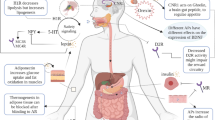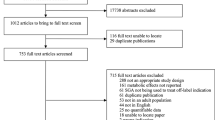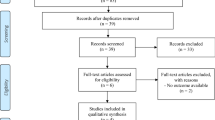Abstract
Second-generation antipsychotics (SGA) are associated with weight gain and metabolic alterations including hyperglycemia, dyslipidemia, hypertension and metabolic syndrome. These metabolic side effects increase cardiovascular risk and are related to medication non-compliance. Patients without previous exposure to these or other antipsychotic drugs (naive patients) seem to be more prone to develop these metabolic abnormalities. The mechanisms behind weight gain can be an increase in food intake and/or a decrease in energy expenditure. This review comprehensively examines the current knowledge on the impact of these drugs on food intake and energy expenditure. The influence of these drugs on appetite and food intake (total caloric intake and food sources) is reviewed as well as the evidence of abnormal eating behaviors. The studies evaluating the effect on resting energy expenditure are critically examined, taking into account the influence of body composition and previous exposure to antipsychotics (naive vs non-naive patients). Finally, the influence of these drugs on physical activity is also discussed. The knowledge of the mechanisms of weight gain in patients starting these drugs may be useful to further prompt research in this field and ameliorate the metabolic side effects associated with these treatments.
This is a preview of subscription content, access via your institution
Access options
Subscribe to this journal
Receive 12 print issues and online access
$259.00 per year
only $21.58 per issue
Buy this article
- Purchase on Springer Link
- Instant access to full article PDF
Prices may be subject to local taxes which are calculated during checkout


Similar content being viewed by others
References
Aparasu RR, Bhatara V . Antipsychotic use and expenditure in the United States. Psychiatr Serv 2006; 57: 1693.
Rani F, Murray ML, Byrne PJ, Wong ICK . Epidemiologic features of antipsychotic prescribing to children and adolescents in primary care in the United Kingdom. Pediatrics 2008; 121: 1002–1009.
Olfson M, Blanco C, Liu SM, Wang S, Correll CU . National trends in the office-based treatment of children, adolescents, and adults with antipsychotics. Arch Gen Psychiatry 2012; 69: 1247–1256.
Ilyas S, Moncrieff J . Trends in prescriptions and costs of drugs for mental disorders in England, 1998–2010. Br J Psychiatry 2012; 200: 393–398.
Aparasu RR, Bhatara V . Patterns and determinants of antipsychotic prescribing in children and adolescents, 2003–2004. Curr Med Res Opin 2007; 23: 49–56.
Fraguas D, Correll CU, Merchán-Naranjo J, Rapado-Castro M, Parellada M, Moreno C et al. Efficacy and safety of second-generation antipsychotics in children and adolescents with psychotic and bipolar spectrum diseases: comprehensive review of prospective head-to-head and placebo-controlled comparisons. Eur Neuropsychopharmacol 2011; 21: 621–645.
Lieberman JA, Stroup TS, McEvoy JP, Swartz MS, Rosenheck RA, Perkins DO et al. Effectiveness of antipsychotic drugs in patients with chronic schizophrenia. N Engl J Med 2005; 353: 1209–1223.
Leucht S, Pitschel-Walz G, Abraham D, Kissling W . Efficacy and extrapyramidal side-effects of the new antipsichotics olanzapine, quetiapine, risperidone, and sertindole compared to conventional antipsychotics and placebo: a metaanalysis of randomized controlled trials. Schizophr Res 1999; 35: 51–68.
Lewis S, Lieberman J . CATIE and CUtLASS: can we handle the truth? Br J Psych 2008; 192: 161–163.
Carpenter WT, Buchanan RW . Lessons to take home from CATIE. Psychiatr Serv 2008; 59: 523–525.
Clark NG . Consensus development conference on antipsychotic drugs and obesity and diabetes. Diabetes Care 2004; 27: 596–601.
Newcomer JW . Second-generation (atypical) antipsychotics and metabolic effects: a comprehensive literature review. CNS Drugs 2005; 19: 1–93.
Allison DB, Casey DE . Antipsychotic-induced weight gain: a review of the literature. J Clin Psychiatry 2001; 62: 22–31.
Goudie AJ, Cooper D, Halford JCG . Antipsychotic-induced weight gain. Diabetes Obes Metab 2005; 7: 478–487.
Gothelf D, Falk B, Singer P, Kairi M, Phillip M, Zigel L et al. Weight gain associated with increased food intake and low habitual activity levels in male adolescent schizophrenic inpatients treated with olanzapine. Am J Psychiatry 2002; 159: 1055–1057.
Cuerda C, Merchan-Naranjo J, Velasco C, Gutierrez A, Leiva M, de Castro MJ et al. Influence of resting energy expenditure on weight gain in adolescents taking second-generation antipsychotics. Clin Nutr 2011; 30: 616–623.
Correll CU, Manu P, Olshanskiy V, Napolitano B, Kane JM, Malhotra AK . Cardiometabolic risk of second-generation antipsychotic medications during first-time use in children and adolescents. JAMA 2009; 302: 1765–1773.
Correll CU, Lencz T, Malhotra AK . Antipsychotic drugs and obesity. Trends Mol Med 2011; 17: 97–107.
Roerig JL, Mitchell JE, Zwaan M, Crosby RD, Gosnell BA, Steffen KJ et al. A comparison of the effects of olanzapine and risperidone versus placebo on eating behaviours. J Clin Psychopharmacol 2005; 25: 413–418.
Fountaine RJ, Taylor AE, Mancuso JP, Greenway FL, Byerley LO, Smith SR et al. Increased food intake and energy expenditure following administration of olanzapine to healthy men. Obesity 2010; 18: 46–51.
Teff KL, Rickels MR, Grudziak J, Fuller C, Nguyen H-L, Rickels K . Antipsychotic-induced insulin resistance and postprandial hormonal dysregualtion independent of weight gain or psychiatric disease. Diabetes 2013; 62: 3232–3240.
Blouin M, Tremblay A, Jalbert ME, Venables H, Bouchard RH, Roy MA et al. Adiposity and eating behaviors in patients under second generation antipsychotics. Obesity 2008; 16: 1780–1787.
Henderson DC, Sharma B, Fan X, Copeland PM, Borba CP, Freudenreich O et al. Dietary saturated fat intake and glucose metabolism impairments in nondiabetic, nonobese patietns with schizophrenia on olanzapine or risperidone. Ann Clin Psychiatry 2010; 22: 33–42.
Sentissi O, Viala A, Bourdel MC, Kaminski F, Bellisle F, Olié JP et al. Impact of antipsychotic treatments on the motivation to eat: preliminary results in 153 schizophrenic patients. Int Clin Psychopharmacol 2009; 24: 257–264.
Case M, Treuer T, Karagianis J, Hoffmann VP . The potential role of appetite in predicting weight changes during treatment with olanzapine. BMC Psychiatry 2010; 10: 72–80.
Kluge M, Schuld A, Himmerich H, Dalal M, Schacht A, Wehmeier PM et al. Clozapine and olanzapine are associated with food craving and binge eating: results from a randomized doubled-blind study. J Clin Psychopharmacol 2007; 27: 662–666.
Theisen FM, Linden A, Kong IR, Martin M, Remschmidt H, Hebebrand J . Spectrum of binge eating aymptomatology in patients treated with clozapine and olanzapine. J Neural Transm 2003; 110: 111–121.
Vidarsdottir S, de Leeuw van Weenen JE, Frölich M, Roelfsema F, Romijn JA, Piel H . Effects of olanzapine and haloperidol on the metabolic status of healthy men. J Clin Endocrinol Metab 2010; 95: 118–125.
Vidarsdottir S, Vlug P, Roelfsema F, Frölich M, Pijl H . Orally disintegrating and oral standard olanzapine tablets similarly elevate the Homeostatic Model Assessment of Insulin Resistance Index and plasma triglyceride levels in 12 healthy men: a randomized crossover study. J Clin Psychiatry 2010; 71: 1205–1211.
Nilsson BM, Forslund AH, Olsson RM, Hambraeus L, Wiesel FA . Differences in resting energy expenditure and body composition between patients with schizophrenia and healthy controls. Acta Psychiatr Scand 2005; 114: 27–35.
Sharpe JK, Byrne NM, Stedman TJ, Hills AP . Resting energy expenditure is lower than predicted in people taking atypical antipsychotic medication. J Am Diet Assoc 2005; 105: 612–615.
Skouroliakou M, Giannopolou I, Kostara C, Vasilopoulou M . Comparison of predictive equations for resting metabolic rate in obese psychiatric patients taking olanzapine. Nutrition 2009; 25: 188–193.
Soreca I, Mauri M, Castrogiovanni S, Simoncini M, Cassano GB . Measured and expected resting energy expenditure in patients with bipolar disorder on maintenance treatment. Bipolar Disord 2007; 9: 784–788.
Virkkunen M, Wahlbeck K, Rissanen A, Naukkarinen H, Franssila-Kallunki A . Decrease of energy expenditure causes weight increase in olanzapine treatment—a case study. Pharmacopsychiatry 2002; 35: 124–126.
Procyshyn RM, Chau A, Tse G . Clozapine’s effects on body weight and resting metabolic rate: a case series. Schizophr Res 2004; 66: 159–162.
Graham KA, Perkins DO, Edwards LJ, Barrier RC, Lieberman JA, Harp JB . Effect of olanzapine on body composition and energy expenditure in adults with first-episode psychosis. Am J Psychiatry 2005; 162: 118–123.
Sharpe JK, Stedman TJ, Byrne NM, Hills AP . Low-fat oxidation may be a factor in obesity among men with schizophrenia. Acta Psychiatr Scand 2009; 119: 451–456.
Sharpe JK, Stedman TJ, Byrne NM, Wishart C, Hills AP . Energy expenditure and physical activity in clozapine use: implications for weight management. Aust N Z J Psychiatry 2006; 40: 810–814.
Bobes J, Arango C, Aranda P, Carmena C, Garcia-Garcia M, Rejas J . Cardiovascular and metabolic risk in outpatients with schizophrenia treated with antipsychotics: results of the CLAMORS study. Schizophr Res 2007; 90: 162–173.
McEvoy JP, Lieberman JA, Perkins DO, Hamer RM, Gu H, Lazarus A et al. Efficacy and tolerability of olanzapine, quetiapine, and risperidone in the treatment of early psychosis: a randomized, double-blind 52-week comparison. Am J Psychiatry 2007; 164: 1050–1060.
Kahn RS, Fleischhacker WW, Boter H, Davidson M, Vergouwe Y, Keet IP et al. Effectiveness of antipsychotic drugs in first-episode schizophrenia and schizophreniform disorder: an open randomized clinical trial. Lancet 2008; 371: 1085–1097.
Kroeze WK, Hufeisen SJ, Popadak BA, Renock SM, Steinberg S, Ernsberger P et al. H1-histamine receptor affinity predicts short-term weight gain for typical and atypical antipsychotic drugs. Neuropsychopharmacology 2003; 28: 519–526.
Henderson DC, Borba CP, Daley TB, Boxill R, Nguyen DD, Culhane MA et al. Dietary intake profile of patients with schizophrenia. Ann Clin Psychiatry 2006; 18: 99–105.
Brown S, Birtwistle J, Roe L, Thompson C . The unhealthy lifestyle of people with schizophrenia. Psychol Med 1999; 29: 697–701.
McCreadie R, Macdonald E, Blacklock C, Tilak-Singh D, Wiles D, Halliday J et al. Dietary intake of schizophrenic patients in Nithsdale, Scotland: case–control study. BMJ 1998; 317: 784–785.
Stokes C, Peet M . Dietary sugar and polyunsaturated fatty acid consumption as predictors of severity of schizophrenia symptoms. Nutr Neurosci 2004; 7: 247–249.
Coccurello R, Moles A . Potential mechanisms of atypical antipsychotic-induced metabolic derangement: clues for understanding obesity and novel drug design. Pharmacol Ther 2010; 127: 210–251.
Jin H, Meyer JM, Mudaliar S, Jeste DV . Impact of atypical antipsychotic therapy on leptin, ghrelin, and adiponectin. Schizophr Res 2008; 100: 70–85.
Sentissi O, Epelbaum J, Olié JP, Poirier MF . Leptin and ghrelin levels in patients with schizophrenia during different antipsychotics treatment: a review. Schizophr Bull 2008; 34: 1189–1199.
Pinheiro Volp AC, Esteves de Oliveira FC, Duarte Moreira Alves R, Esteves EA, Bressan J . Energy expenditure: components and evaluation methods. Nutr Hosp 2011; 26: 430–440.
Webb P . Energy expenditure and fat-free mass in men and women. Am J Clin Nutr 1981; 34: 1816–1826.
Ravussin E, Bogardus C . Relationship of genetics, age, and physical fitness to daily energy expenditure and fuel utilization. Am J Clin Nutr 1989; 49: 968–975.
McClave SA, Lowen CC, Kleber MJ, McConnell JW, Jung LY, Goldsmith LJ . Clinical use of the respiratory quotient obtained from indirect calorimetry. J Parenter Enteral Nutr 2003; 27: 21–26.
Author information
Authors and Affiliations
Corresponding author
Ethics declarations
Competing interests
The authors declare no conflict of interest.
Rights and permissions
About this article
Cite this article
Cuerda, C., Velasco, C., Merchán-Naranjo, J. et al. The effects of second-generation antipsychotics on food intake, resting energy expenditure and physical activity. Eur J Clin Nutr 68, 146–152 (2014). https://doi.org/10.1038/ejcn.2013.253
Received:
Revised:
Accepted:
Published:
Issue Date:
DOI: https://doi.org/10.1038/ejcn.2013.253
Keywords
This article is cited by
-
The effects of antipsychotic medications on microbiome and weight gain in children and adolescents
BMC Medicine (2019)
-
Food craving and consumption evolution in patients starting treatment with clozapine
Psychopharmacology (2019)
-
Psychotropic usage by patients presenting to an academic eating disorders program
Eating and Weight Disorders - Studies on Anorexia, Bulimia and Obesity (2018)
-
The effects of antipsychotics on weight gain, weight-related hormones and homocysteine in children and adolescents: a 1-year follow-up study
European Child & Adolescent Psychiatry (2017)
-
Body mass index in dementia
European Journal of Clinical Nutrition (2014)



